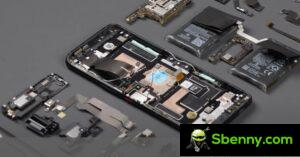The Nokia N95 was a highlight for Symbian, but as we noted in our previous Flashback article, its success has never been replicated. It was also the end of this form factor: the Swiss Army knife slider phone.
The original N95 arrived in early 2007, followed a few months later by the much improved N95 8GB. Our destination for today’s story is the N86 8MP, but we have a winding path to get there.
2007 also brought the more affordable Nokia N81. It launched in two versions: one with virtually no built-in storage but with a 2GB microSD card included, and one with 8GB of built-in storage but no microSD card. Their price was 360 and 430 euros respectively before taxes. For comparison, the Nokia N95 8GB cost 560 euros before taxes.




Nokia N818GB
8GB was quite large for the time, when the original iPod launched in 2001 it had 5GB of memory and was advertised as having “1,000 songs in your pocket”. So, the 8GB N81 can hold dozens of music CDs and tons of photos too.




8GB was a lot of storage for music and videos
Not that the phone had a particularly good camera, a disappointing 2MP sensor (no AF) with LED flash and video recording at 320p @ 15fps. It was nothing like the 5 MP camera with Carl Zeiss optics and 480p video at 30 fps that the flagship Nokia N95 had to offer.




The less said about the camera, the better
But that wasn’t all the N81 had to offer, the phone was part of the N-gage family, making it a gaming phone of sorts. An awkward gaming phone as the D-pad wasn’t really up to par. And the 2.4″ 240 x 320px display was decent, but again not up to par with what the N95 had on board (2.6″ for the original and 2.8″ for the N95 8GB).




Nokia N81 and Nokia N85gsmarena_01
A year later the Nokia N85 arrived with a price of 450 euros before taxes. This was the first Nokia smartphone with an AMOLED display, a 2.6-inch panel with the familiar 240 x 320 px resolution. The Finns used AMOLED on some other models, but those were artistic phones like the Nokia 8800 Arte and the Nokia 7900 Prism.




The inky blacks of the Nokia N85’s AMOLED display were a sight to behold
The N85 was a huge upgrade overall. The unique display was definitely the highlight, but the phone was also upgraded to 5MP with Carl Zeiss optics with autofocus this time and proper 480p video capture at 30fps.




The new 5MP camera was much better
This model also achieved the N95 in other ways, for example it had a GPS receiver. Pre-installed Nokia Maps offered three months of voice-guided navigation for free (something that was still a paid feature at the time).




Navigation in the era before Google Maps went mobile
And the phone itself also had a dual-slider design like the N95, meaning that sliding it one way showed the keyboard, sliding it the other showed the media controls.




The Nokia N85 adopts dual slider design
Speaking of multimedia, the N85 also had stereo speakers like its bigger brother. Instead of splitting the phone into two models (one with 8GB of storage and one with a microSD slot), the Finns decided to package just one 8GB microSD.
Before we get to the N86, we need to talk about the successor to the N95 – the Nokia N96. It was supposed to be released in early 2008, but delays pushed it back to September. It managed to get more expensive, 550 euros before tax, and looked underwhelming for Nokia’s traditional Symbian flagship (the company was trying to graft a touch UI onto the operating system, but it didn’t work well). The US model cost a whopping $900, which is a high price for a phone even today, let alone 2008.




The Nokia N96 was way overpriced
Let’s just say that the N96 wasn’t very successful in the market. In case the timing eludes you, the iPhone 3G launched in 2008. It was available with heavy subsidies from AT&T, so an 8GB model cost $200, a 16GB one cost $300. A year later, the The iPhone 3GS retailed with a no-contract price of $500 for the 8GB model and $550 for the 16GB model. $900 for a Symbian phone without a touchscreen was delusional.
And with this we arrive at our destination: the Nokia N86 8MP arrived in 2009 at a reasonable price of €375 excluding taxes. This made it the cheapest 8GB model in the series and cost just €15 (excl. tax) more than the N81 with a 2GB microSD card from a couple of years earlier. And the N86 was by far the best of the series, almost as good as the N95. Maybe even better.




The Nokia N86 8MP was very capable and quite affordable
This was the first Nokia phone with an 8MP camera (hence the name). Carl Zeiss was once again signed on for the optics and the phone enjoyed a more powerful dual-LED flash. As before, it could record 480p video at 30 fps. This was also the first Nokia phone to feature a wider, 28mm lens, which allowed it to capture more of the scene than contemporary phones (and it had the resolution to do so).

FoV comparison: Nokia N86 (28mm) and Samsung INNOV8 (35mm)
But that’s not all, the camera had a variable aperture that could go up to f/2.4 or f/4.8 depending on the lighting conditions. And there was a mechanical shutter (in addition to the protective slider that went over the lens), plus an actual shutter button, of course. As for video, the phone was equipped with MEMS microphones and promised CD-quality audio.
Here are some camera examples from the N86:






Nokia N86 8MP camera examples
It had the now-familiar dual-slider design, but also featured a built-in kickstand, if you wanted to leave it on the table and watch some videos. The N86 8MP had the best of both worlds: 8GB onboard and an available microSD slot for even more storage.




Nokia N86 8MP next to the N81
And you can watch videos (and play games) on the vibrant 2.6-inch AMOLED display (still with a resolution of 240 x 320 px). This time Nokia spent a fortune on scratch-resistant glass to ensure the display stays beautiful.
Like its predecessor, the Nokia N86 8MP was launched with a GPS receiver. Initially, you still had to pay for voice-guided navigation, but in early 2010 (several months after the N86 launched), Nokia released Ovi Maps for free. Additionally, the phone has gained the ability to share your location on Facebook. A few months after the initial launch, Ovi Maps was updated to use Wi-Fi for faster positioning, searching, panning and zooming the map also became faster.




Ovi Maps – free navigation for the Nokia N86 (image credit)
As touchscreen phones began to take over the world in 2009 (the iPhone led the charge, early Androids followed), the old Nokia N86 8MP was great value for money, especially after the Ovi Maps update.
It had a great camera, was a multimedia wizard (with things like an FM transmitter, DVB-H TV receiver, and analog video output), drove you around the world for free, and even played a few games.
This, however, was the swansong for the form factor. There were rumors about a Nokia N87 – someone actually sold a prototype of the N87 on eBay, so it was a very real device – but it was never officially released. It also looked like a dream with a 12MP Carl Zeiss camera with xenon flash (apparently borrowed from the Nokia N8) and presumably a touch user interface.

A prototype of the Nokia N87 published on eBay
Nokia was changing gears: the time of Symbian Series 60 3rd edition was coming to an end, new models were designed for touch with the 5th edition (later renamed Symbian^1). But as we have already said, the operating system failed to adapt to the new world. The follow-up Symbian^3 Anna and Belle looked promising, but that’s a story for another time (and it’s not a story with a happy ending).
Former Symbian partners like Sony and Motorola have abandoned the platform en masse to hitch their wagons to Android. Not Nokia, though. The Finns abandoned Symbian (and MeeGo) in favor of Windows Phone. In any case, with physical keys out of fashion, there was little need for sliders, unless you were trying to hide a full QWERTY keyboard like on the N97.
It was the end of the era, but at least multimedia sliders like the Nokia N95 and N86 came out in style. That’s more than can be said for their touch-focused successors.







Start a new Thread